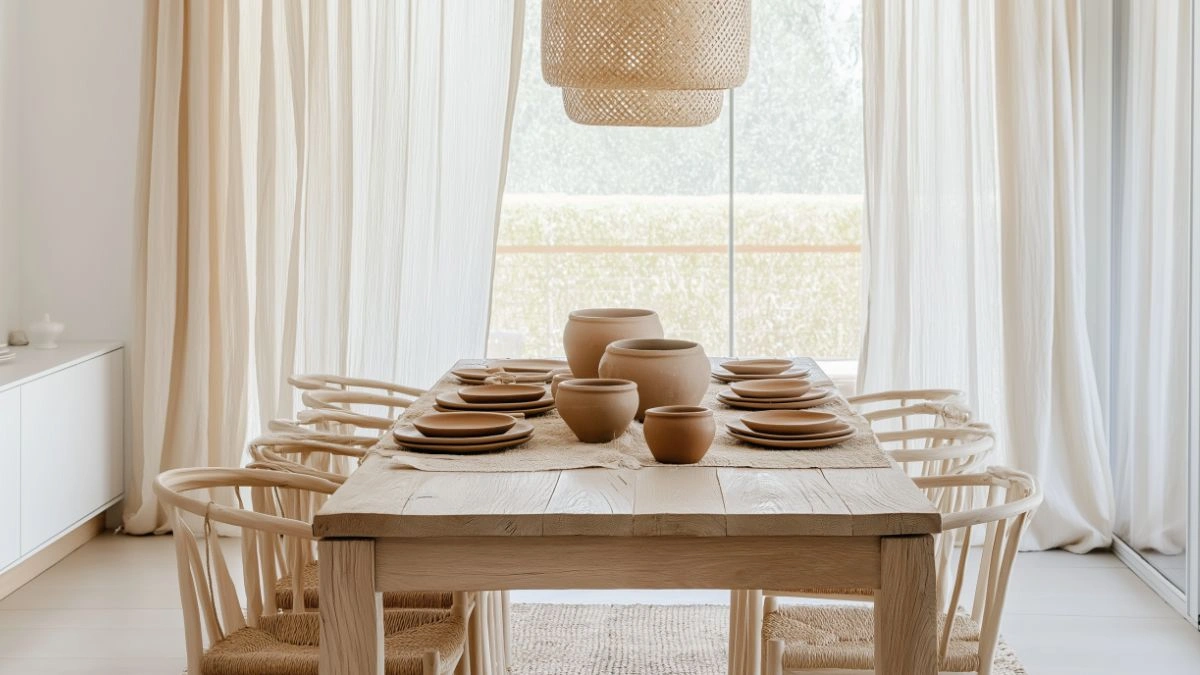Organic Modern Dining Room Decor Tips to Create a Cozy, Inviting Ambiance
Table of Contents
What makes a dining room truly inviting? It’s more than a beautifully set table—it’s the ambiance. The feeling of warmth, calm, and intentional design can turn everyday meals into cherished rituals. Enter the organic modern style: a blend of clean lines, earthy materials, and a warm, understated aesthetic that’s as cozy as it is current.
With the rise of wellness-focused interiors, more homeowners are leaning into organic modern dining room decor. According to interior design reports, natural textures and warm minimalism are topping 2025 trend charts—and it’s easy to see why. Organic modernism creates a serene backdrop for both casual meals and elegant gatherings, emphasizing comfort, function, and beauty.
In this post, we’ll explore practical and inspiring tips for achieving an organic modern look in your dining room. From choosing the right furniture and lighting to layering textures and decor, every section offers actionable ideas to help you cultivate a cozy, grounded space. Whether you’re working with a compact nook or a spacious open-plan layout, these design tips will guide you in creating a dining area that feels as good as it looks.
Start with Natural Materials for an Earthy Foundation
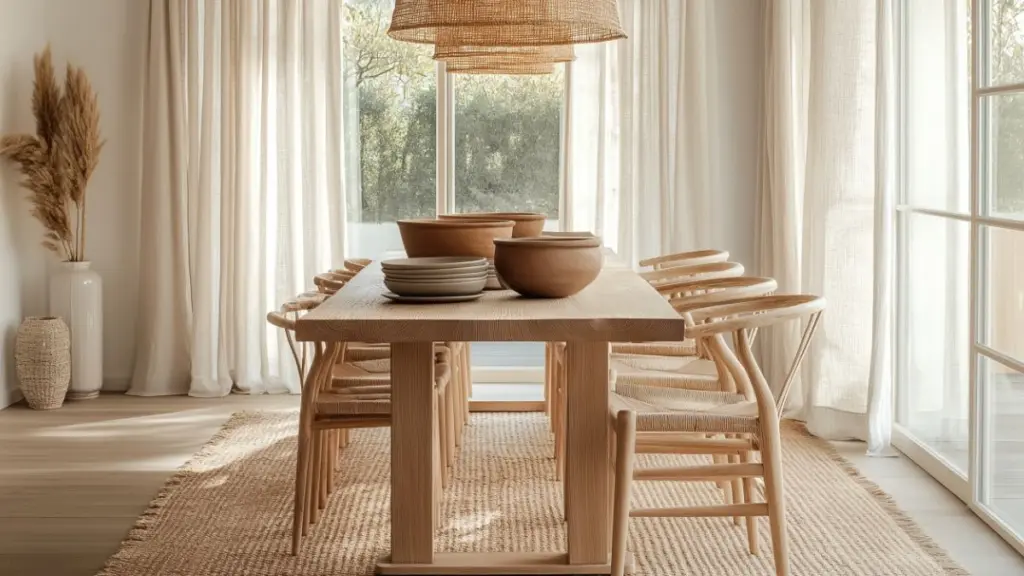
The foundation of any organic modern dining room is rooted in nature. Materials like wood, stone, linen, and rattan add a tactile richness that artificial surfaces can’t replicate. Opt for pieces that showcase natural imperfections—like wood grain, veining in stone, or woven variations in textiles. These “flaws” add character and make the room feel grounded.
A solid wood dining table serves as the anchor piece. Whether it’s reclaimed oak, walnut, or light ash, the natural finish adds warmth and complements both minimalist and rustic elements. Pair this with woven or upholstered chairs in neutral tones. Avoid anything too glossy or manufactured-looking; matte finishes and tactile textures are key.
Complement the setting with stoneware dishes, terracotta planters, and jute rugs. The goal is to create a sensory experience that feels peaceful, authentic, and connected to the outdoors.
Material Inspiration Table
| Material | Best Use Case | Style Benefit |
|---|---|---|
| Reclaimed Wood | Dining table, wall accents | Adds warmth and unique patina |
| Linen | Curtains, tablecloths, cushions | Light, breathable, and textured |
| Rattan/Wicker | Seating, light fixtures | Casual, cozy touch with vintage feel |
| Stone/Clay | Tableware, planters | Earthy tones with handcrafted charm |
Choose a Warm and Minimalist Color Palette
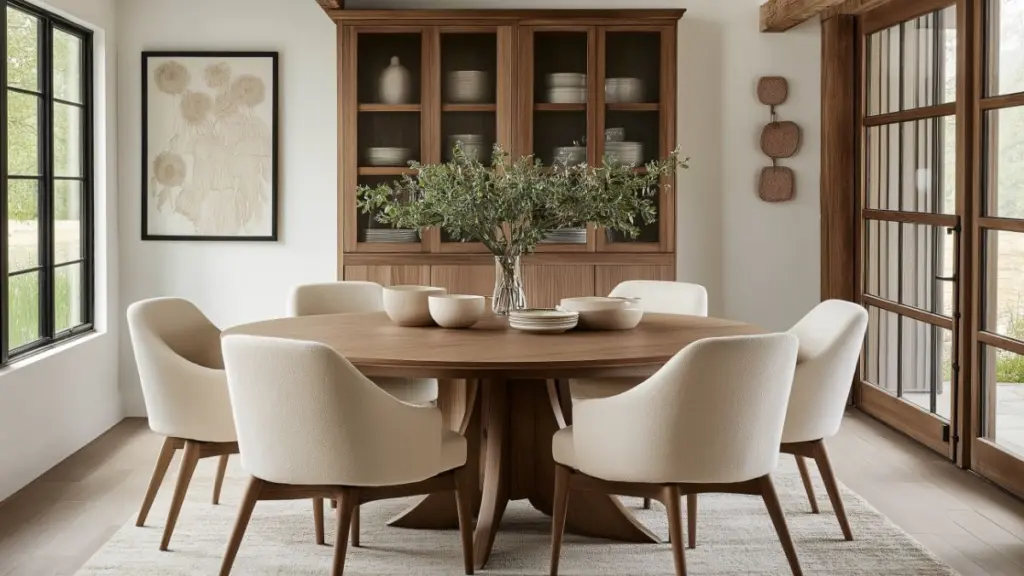
Color sets the mood in any room, and the organic modern palette focuses on warm neutrals, soft earth tones, and desaturated hues. Think creamy whites, mushroom greys, sand, olive, and muted terracotta. These colors make a space feel cozy without being overly busy.
Avoid stark contrasts—this style is more about layering similar tones than using dramatic differences. Pair off-white walls with warm beige textiles, light oak floors, and walnut chairs. Bring in black or deep bronze sparingly through fixtures or frames to ground the space.
One of the best ways to incorporate this palette is through textiles and decor. Swap in beige linen napkins, soft green cushions, or taupe table runners. Keep the background simple and let materials and texture do the talking.
Organic Modern Color Palette
| Base Color | Accent Pairings | Mood Created |
|---|---|---|
| Warm White | Mushroom, soft gold, camel | Clean and inviting |
| Olive Green | Terracotta, ivory, light brown | Earthy and calming |
| Sandy Beige | Cream, driftwood, copper | Coastal and soft |
| Charcoal Brown | Bone white, matte black, tan leather | Sophisticated and balanced |
Layer in Textures to Build Warmth
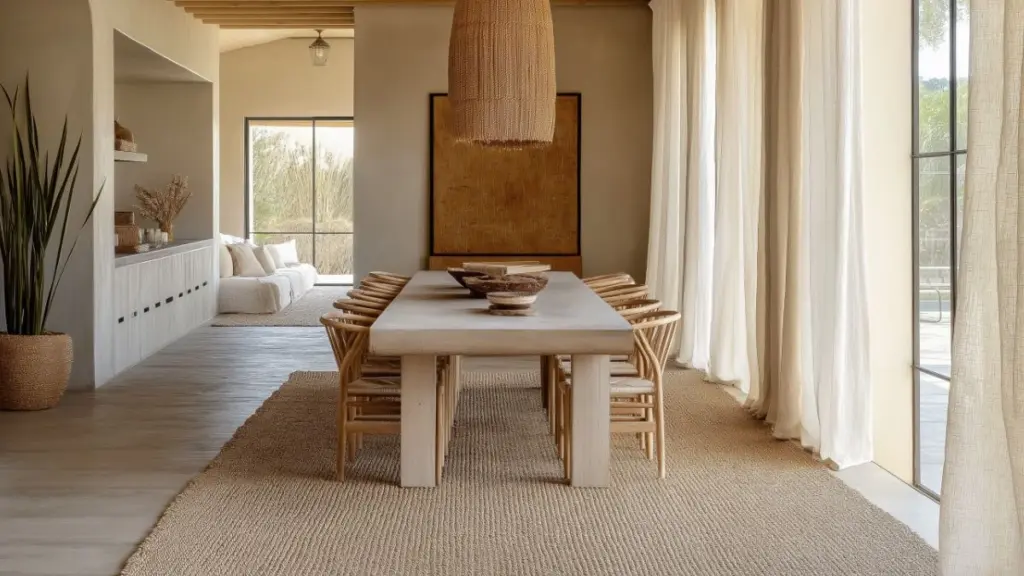
One of the defining traits of organic modern design is its use of layered textures to create visual interest and warmth. A space that relies solely on minimalism can sometimes feel cold—but introducing tactile elements instantly changes that.
Start with textiles: linen or cotton drapery, wool throws on dining benches, or canvas slipcovers on chairs. Then, add hard textures like matte ceramics, woven baskets, and plaster wall finishes. Even subtle additions—like a leather seat cushion or a handwoven runner—make a big impact.
Don’t overlook the ceiling and floor. Wooden ceiling beams, textured pendant lights, or a wool-blend area rug can tie the space together with understated elegance.
Texture Layering Ideas
| Element | Texture Type | Design Role |
|---|---|---|
| Curtains | Washed linen | Soften windows, filter light |
| Rugs | Jute, wool blend | Anchor the space and add warmth |
| Table Decor | Matte ceramics, woven trays | Create rustic yet refined tablescapes |
| Wall Finishes | Limewash, natural plaster | Adds depth without color |
Incorporate Organic Shapes and Flowing Lines
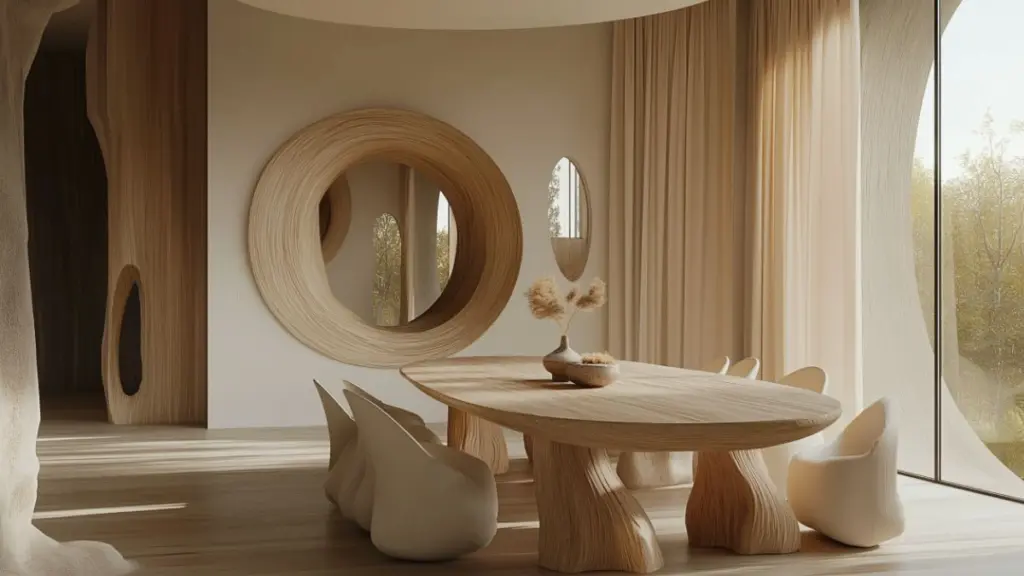
While modern design often leans on clean, sharp lines, organic modernism softens the look with curves and flowing forms. This approach adds a more human, approachable feel—ideal for a space that invites conversation and togetherness.
Swap out square-edged furniture for round or oval tables. Curved back chairs, arched doorways, or circular lighting fixtures reinforce this softness. Even accessories like round mirrors, organic-shaped ceramics, or asymmetrical wall art contribute to the effect.
These shapes echo the natural world—stones, leaves, rivers—and infuse movement into the room. They also break up the rigidity that can come with overly structured modern design, creating visual ease and calm.
Organic Shape Styling Tips
| Shape/Form | Placement Suggestion | Visual Impact |
|---|---|---|
| Round/Oval Table | Central focal point | Encourages flow and inclusivity |
| Curved Chair Backs | Around dining table | Adds softness and comfort |
| Arched Mirrors/Art | On feature wall | Reflects light, balances angles |
| Freeform Ceramics | On sideboard or open shelf | Brings handcrafted, one-of-a-kind feel |
Use Lighting to Create a Cozy Dining Experience
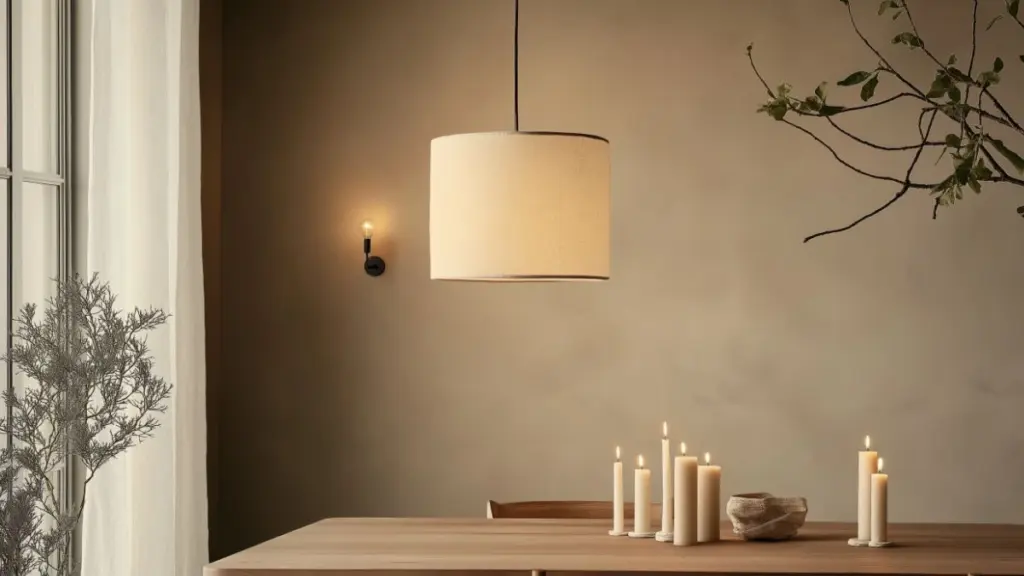
Lighting sets the emotional tone of a room, especially in a dining space. In an organic modern setting, the goal is to balance function with atmosphere—soft, ambient light that complements natural textures and tones.
Pendant lights made from natural materials like rattan, wood, or linen shades offer gentle diffusion. Consider hanging a single statement fixture over the table or a row of smaller pendants for a more modern look. Choose warm LED bulbs with a color temperature between 2700K and 3000K for the coziest glow.
Layer lighting sources for depth: sconces on the wall, a small lamp on a sideboard, and candles or tea lights on the table. If the room gets good natural light, opt for sheer curtains that filter light during the day while maintaining privacy.
Lighting dimmers can also be a game-changer—adjusting brightness lets you shift from functional family dinners to intimate evening settings with ease.
Lighting Strategy Breakdown
| Type of Lighting | Where to Use | Benefit |
|---|---|---|
| Pendant Light | Above dining table | Defines the space, adds visual interest |
| Wall Sconces | Side walls or archways | Softens shadows, balances layout |
| Sideboard Lamp | On buffet or console table | Adds glow and depth |
| Candles/Tealights | On dining table or shelf | Creates cozy, intimate mood |
Balance Minimalism with Organic Accents
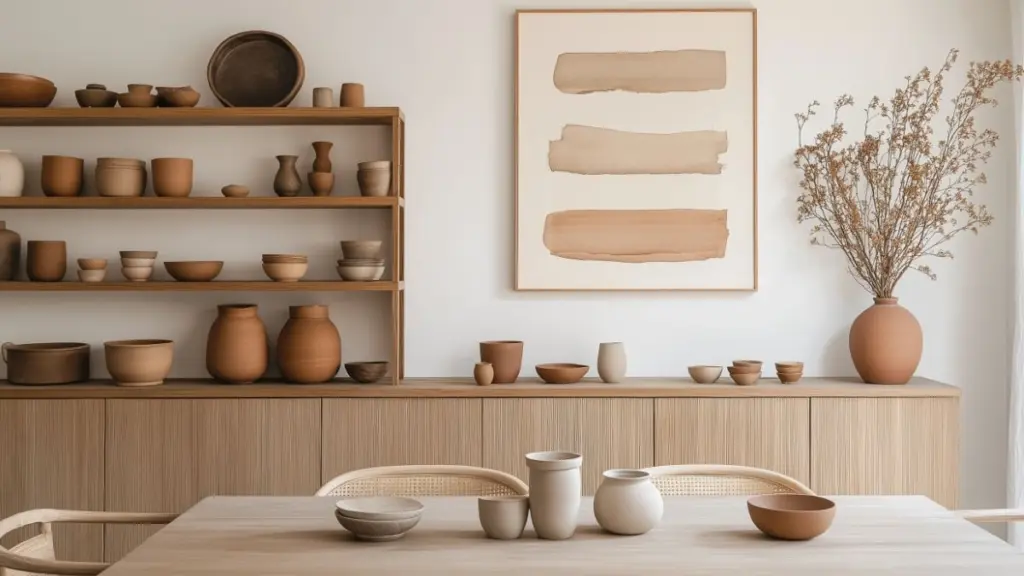
While organic modern decor leans minimalist, it should never feel sterile. The balance lies in letting go of clutter while layering in meaningful, nature-inspired accents.
Choose decor that serves a purpose or evokes emotion. Think handmade pottery, sculptural vases, driftwood, or vintage baskets. Display a curated set of favorite ceramics on an open shelf rather than filling the space with unnecessary objects.
Books, artwork, and nature-inspired pieces can make the space feel personal without overwhelming the design. Stick to a rule of three when styling surfaces and let negative space play its part.
Minimalist Styling Tips
| Area | Accent Type | Keep in Mind |
|---|---|---|
| Open Shelves | Pottery, glass, wood trays | Use odd numbers and vary heights |
| Dining Table | Vase, runner, candles | Keep center clear for practical use |
| Walls | Natural prints, simple frames | Let artwork breathe with space around it |
| Corners | Baskets, standing plants | Use floor space wisely but sparingly |
Bring Nature Indoors with Greenery and Florals

No organic-inspired room is complete without a touch of greenery. Houseplants, dried florals, or fresh seasonal arrangements bring life and movement into your dining room while reinforcing the connection to the natural world.
Use sculptural plants like olive trees, monstera, or rubber figs in woven baskets for a grounded, earthy feel. On the table, a simple ceramic vase with eucalyptus stems or dried grasses is all you need for a subtle statement.
Even herbs in small planters can be functional and beautiful if your dining room connects to a kitchen or open living space.
Greenery Styling Guide
| Plant/Floral Type | Best Placement | Design Role |
|---|---|---|
| Olive Tree or Fiddle Fig | Corner of room or behind bench | Adds height and softness |
| Eucalyptus or Pampas | Table vase or wall-mounted jar | Earthy and low-maintenance |
| Small Potted Herbs | Window sills, shelf ends | Fresh and practical |
| Seasonal Fresh Flowers | Center of table or buffet | Adds color and fragrance |
Conclusion
Designing an organic modern dining room is all about balance—pairing simplicity with soul, functionality with beauty, and minimalism with warmth. By focusing on natural materials, muted color palettes, soft textures, and thoughtful lighting, you can craft a dining space that’s both stylish and serene.
Whether you’re sharing meals with family or hosting friends, a cozy ambiance invites presence, conversation, and calm. Through intentional decor and a connection to nature, your dining room becomes not just a place to eat—but a place to live well.

